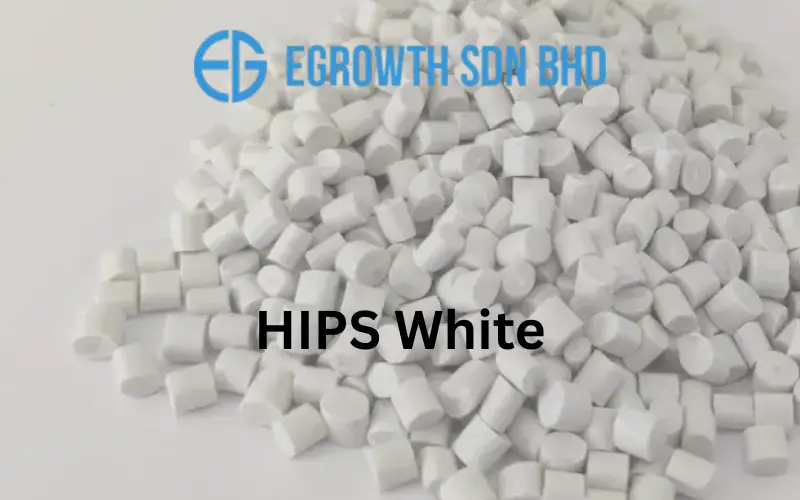In the fast-paced world of plastic manufacturing, where efficiency, durability, and budget constraints often dictate success, HIPS White has solidified its position as a top choice for producers worldwide. Short for High Impact Polystyrene White, this versatile thermoplastic is renowned for its balance of performance and affordability, making it ideal for a wide range of applications from consumer goods to industrial components. As manufacturers grapple with rising material costs and sustainability demands, HIPS White stands out for its low production expenses, ease of processing, and reliable mechanical properties. This article explores the reasons behind HIPS White’s popularity, delving into its composition, benefits, real-world applications, and how it compares to alternatives, ultimately revealing why it’s a cornerstone of cost-effective manufacturing strategies.
Understanding HIPS White: Composition and Basic Properties
HIPS White is a modified form of polystyrene, a polymer derived from styrene monomers, enhanced with rubber additives to improve its impact resistance. The “White” designation typically refers to its opaque, bright white coloration, achieved through the addition of pigments during extrusion or injection molding. At a molecular level, HIPS is a graft copolymer where polybutadiene rubber is dispersed within a polystyrene matrix, providing the material with excellent toughness without sacrificing rigidity.
One of the key reasons HIPS White is favored is its straightforward composition, which allows for easy manufacturing. It’s produced through processes like extrusion, injection molding, or thermoforming, requiring relatively low temperatures (around 180-260°C) compared to more complex plastics. This thermal efficiency translates to energy savings, reducing operational costs for manufacturers. Additionally, HIPS White is lightweight, with a density of about 1.04 g/cm³, which means less material is needed for the same volume, further cutting expenses in shipping and handling.
From a performance standpoint, HIPS White offers a tensile strength of 15-30 MPa and a high elongation at break, making it durable enough for everyday use while remaining flexible. Its surface is smooth and paintable, allowing for easy customization, which is a boon for branding and aesthetics in consumer products. These properties make HIPS White not just a cost-effective option but a practical one, enabling manufacturers to produce high-quality items without overinvesting in raw materials.
Cost-Effective Advantages of HIPS White in Manufacturing
The primary allure of HIPS White lies in its economic benefits, which span the entire production lifecycle. First and foremost, it’s inexpensive to source. As a commodity plastic, polystyrene is abundantly available and derived from petroleum byproducts, keeping raw material costs low often 20-30% cheaper than engineering plastics like ABS or polycarbonate. This affordability is crucial for small to medium enterprises (SMEs) looking to scale without significant upfront investments.
- Low Processing Costs: HIPS White has excellent flow properties, meaning it can be molded quickly and efficiently, reducing cycle times in injection molding by up to 15-20%. This efficiency lowers labor and energy expenses, as machines operate at optimal speeds with minimal waste.
- Recyclability and Waste Reduction: HIPS is highly recyclable, with regrind material often reused in new production runs. Manufacturers can incorporate up to 25% recycled content without compromising quality, which not only cuts material costs but also aligns with global sustainability goals, potentially qualifying for green incentives.
- Versatility in Design: Its ability to be easily thermoformed or vacuum-formed allows for complex shapes with minimal tooling changes. This flexibility reduces the need for expensive molds, enabling rapid prototyping and shorter time-to-market for products.
Moreover, HIPS White’s impact resistance ensures longevity, reducing the frequency of product failures and returns, which indirectly saves money on warranties and customer service. In an industry where profit margins can be slim, these cumulative savings add up, making HIPS White a smart choice for cost-conscious operations.
Real-World Applications and Performance in Various Industries
HIPS White’s adaptability shines in its diverse applications, from packaging and electronics to automotive parts. In the packaging sector, it’s commonly used for disposable containers, trays, and lids due to its food-grade safety and barrier properties against moisture. For instance, in the food industry, HIPS White is ideal for yogurt cups or fast-food containers because it maintains structural integrity at low temperatures while being cost-effective to produce in high volumes.
In electronics, HIPS White forms the casing for devices like computer monitors or household appliances, where its electrical insulation and dimensional stability are key. Its white color also provides an excellent base for printing logos or instructions, enhancing product appeal without additional coatings. The automotive industry benefits from HIPS White in interior components, such as dashboard panels or trim pieces, where its resistance to impact and chemicals ensures durability at a fraction of the cost of metals or advanced composites.
Performance-wise, HIPS White excels in environments with moderate stress. It has a good balance of stiffness and flexibility, with a Vicat softening point of around 90-100°C, making it suitable for items exposed to everyday handling. However, it’s not ideal for high-heat applications, as it can warp above 80°C, but this limitation is offset by its low cost, allowing manufacturers to select it for appropriate uses and reserve pricier materials for extreme conditions.
Comparing HIPS White to Other Materials: Why It Wins on Cost
When pitted against other plastics, HIPS White consistently emerges as the go-to for budget-friendly manufacturing. Compared to polypropylene (PP), which offers better chemical resistance but at a higher price point, HIPS White is lighter and easier to process, reducing overall production costs by 10-15%. Against ABS (Acrylonitrile Butadiene Styrene), which boasts superior strength, HIPS White is cheaper and sufficient for non-structural applications, saving manufacturers up to 25% per unit.
- Versus PVC: While PVC provides excellent weatherability, it’s more expensive and environmentally contentious due to its chlorine content. HIPS White, being free of heavy metals, offers a cleaner alternative without the regulatory hurdles.
- Environmental Footprint: In an era of eco-regulations, HIPS White’s recyclability gives it an edge over non-recyclable options like certain foams, potentially lowering long-term costs through waste management rebates.
This comparative advantage is evident in case studies, such as a 2022 report from the Plastics Industry Association, which highlighted that companies switching to HIPS White for consumer goods reduced material expenses by 18% while maintaining product performance.
Challenges and Considerations for Using HIPS White
Despite its benefits, HIPS White isn’t without drawbacks, which manufacturers must address for optimal results. One challenge is its lower resistance to UV light and chemicals, leading to yellowing over time in outdoor applications. To mitigate this, additives like UV stabilizers can be incorporated at a minimal extra cost, extending the material’s lifespan.
Another consideration is flammability; HIPS is moderately flammable, so for applications requiring fire resistance, flame-retardant variants are available, though they slightly increase costs. Additionally, as global supply chains face volatility, sourcing consistent quality HIPS White requires reliable suppliers, but its widespread availability helps buffer against price spikes.
By planning for these factors, manufacturers can leverage HIPS White’s strengths, ensuring it remains a cost-effective staple.
The Future of Cost-Effective Manufacturing with HIPS White
In summary, HIPS White’s combination of affordability, processability, and performance makes it an indispensable material in cost-effective plastic manufacturing. From its low raw material costs and energy-efficient processing to its versatility across industries, it empowers businesses to innovate without breaking the bank. As the manufacturing landscape evolves with pressures for sustainability and efficiency, HIPS White’s recyclability and adaptability position it for continued dominance.
For companies aiming to optimize operations, embracing HIPS White could be the key to competitive edge. Whether you’re a startup prototyping products or a large firm scaling production, this material’s proven track record underscores its value. In a world where every penny counts, HIPS White isn’t just a choice it’s a strategic imperative for success in plastic manufacturing.


